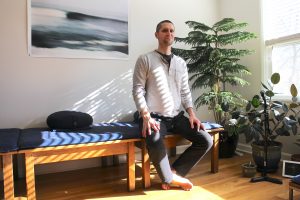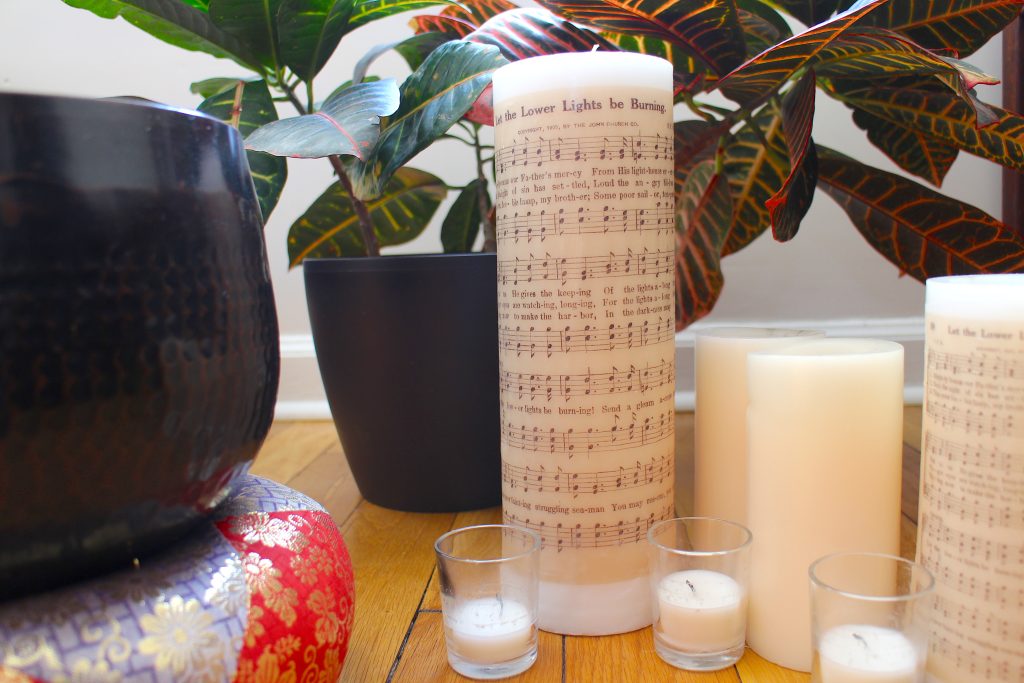The first thing that I noticed on my visit to Thomas McConkie’s apartment near the University of Utah was a small wooden tan—the raised platform where monks sit during meditation in the traditional Zen Buddhist temples.
“One of our members made it for me,” McConkie said, taking a seat on a black cushion. His impeccable posture and loose, comfortable clothing suggested that the tan wasn’t for show.
A large white candle was decorated with a hymnal page titled “Let the Lower Lights Be Burning.”
“It’s a 19th-century hymn that’s become very popular in the Mormon church,” said McConkie, a Salt Lake City native whose spiritual odyssey has brought him back to the religion of his family, which has deep roots in Utah’s Mormon history.
“If we’re all storm-tossed and looking for safe harbor, the upper lights—the sun, the moon and the stars—can only guide us so far,” McConkie explained, picking up the candle to illustrate his point. “When we really need to bring the ship in and dodge the sharp rocks, it’s the lower lights, the lighthouses and other lights that we humans create for one another, that actually allow us to make the journey.”

But McConkie is not making his journey alone. The next evening, in a spectacular, century-old building that originally housed the Ladies’ Literary Club of Salt Lake City, he led 200 people—most of them from Mormon families—through a guided meditation at a monthly gathering of the Lower Lights Sangha.
Mormonism has continued to grow in the U.S., despite the broader downward trend in membership among other Christian denominations. Still, like many traditional institutions in this era of religious disaffiliation, the Church of Jesus Christ of Latter-day Saints is having a tough time retaining young adults who were born into the faith. Lower Lights Sangha is, in part, a laboratory where a new generation of Mormons is shaping novel expressions of the faith that include a form of meditation derived from Buddhism.
“It speaks to the character of 21st century religion in American,” said Patrick Mason, the Hunter Chair of Mormon Studies at Claremont Graduate University in California. Mason, who has met McConkie and tracked reports from people who have participated in Lower Lights, sees the group’s integration of contemplative practice and Mormon faith as an indication that we are living in a spiritually experimental time.
“LDS practice and identity have been pretty exclusive,” Mason said. “There’s not a lot of hybridity with Mormon practice—this certainly would represent something new.”
McConkie was dissatisfied with his faith from an early age.
At 13, he started refusing to go to church—a dramatic act of rebellion in a devout Mormon family. His family and community responded to his defiance by shaming him and shunning him, he recalled. Though he was a dedicated athlete in high school, he was also using drugs to deal with the pressure at home.
McConkie’s adolescent break with the LDS Church was complete by the time he was 19, not long after participating in a retreat at Kanzeon Zen Center. At the age when most Mormons are expected to undertake an evangelizing mission, McConkie left his family and his faith behind to try to find his own path.
“I got up in the middle of a night and I bought a plane ticket to California,” he said. “I didn’t tell a soul. I just disappeared.”
McConkie, now 37, returned to his hometown of Salt Lake City in 2011, after a peripatetic decade that included extended sojourns in Southern California, China, Spain, New York City and Quebec.
Soon after coming home, he signed up for a meditation retreat led by Joshu Sasaki Roshi at Mt. Baldy Zen Center in Southern California. (McConkie had connected with one of Sasaki Roshi’s students during his time abroad, and became a formal student in Sakaki’s lineage in 2010.) On the last day of the retreat McConkie had a kensho—not a complete enlightenment experience, but a brief spiritual opening that he says allowed him to step back from the last vestiges of the old identity he had been rebelling against since his adolescence. When he returned to Salt Lake City, he said, the new person who emerged surprised everyone—including himself.
“That’s very much been my practice here [in Salt Lake City], to learn to bring love and freedom to the darkest places of my life,” he said.
People began to ask McConkie about his meditation practice, and in February 2012 he opened his apartment on Lincoln Street for guided meditations on Wednesday nights.
News of the group spread by word of mouth, and by early 2016 the Lincoln Sangha was looking for a place to hold monthly gatherings for the hundreds of people who had come through McConkie’s door. Lower Lights Sangha met at the Ladies’ Literary Club building for the first time in September 2016.
McConkie sees his integration of Mormon faith with Zen practice—along with Vipassana and elements of Ken Wilber’s integral theory—as a natural expression of both Mormonism itself and the more general evolutionary process of human spiritual development.
“Joseph Smith and his followers were all looking to recover the practices and the charisms of the early Church,” McConkie said. “It’s also very clear in Mormon history that the impulse to restore that spirit is also way of shaping the future.”
McConkie points to the concept of “ongoing revelation” in the Mormon Church to explain the integration of his practices. “There are truths that we do not yet understand and have not yet integrated into what we call Mormonism,” he explained.
McConkie’s spiritual bricolage might seem incompatible with a religious tradition that can appear more monolithic than most. But according to Patrick Mason of Claremont Graduate University, there are precedents for the Lower Lights experiment.
“Spiritualism was the mindfulness of its day,” Mason said, remarking that Lower Lights shares some similarities with a group of LDS reformers who were involved in ritual communication with spirits of the dead during the second half of the 19th century.
“People generally saw it as a sort of ecumenical practice,” Mason explained. “And the Mormon spiritualists said, ‘We’re not doing anything remarkable. We’re communing with the spirit of Joseph Smith!’”
Mason also said that strand of ecumenism persists in present-day Mormonism.
“Mormons would say there’s only one truth out there,” he said, “but God continues to teach us, and we seek truth whenever we find it. You could express that sentiment in any LDS Sunday school. It’s not hostile to our faith.”
The fact that McConkie integrates mainstream Mormon doctrine with a new contemplative approach to devotional practice has won him a remarkable degree of acceptance within Salt Lake City’s Mormon establishment. He has made presentations on his teaching at Lower Lights for administrators in the church’s main offices, and he was invited to produce a podcast (Mindfulness+) for the church-owned news radio station, KSL.
While not everyone has responded to his work with that degree of openness, McConkie said that skepticism from other Mormons has entailed a cold shoulder rather than expressions of hostility.
“I would say there has naturally been pushback,” McConkie said. “Those who feel comfortable with the way things are will tend to wonder what we’re up to, or ask why it’s even necessary. At worst, they ignore us.”
Ultimately, McConkie hopes to see the positive transformation in his own life mirrored in his sangha as well as the religious tradition that he continues to call his own.
“We know that meditative awareness is good for the body, good for the mind, good for interpersonal relationships,” he said. “To the extent that the Church approves of that and adopts any of that—if it helps turn that institution even one degree, it will affect millions of lives.”
Thank you for subscribing to Tricycle! As a nonprofit, we depend on readers like you to keep Buddhist teachings and practices widely available.
